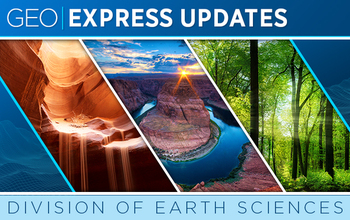Division of Earth Sciences Express Update - Fall 2017 Vol. 2
November 15, 2017
|
Apply now for an NSF Division Director position (AGS, EAR, OCE) in the Directorate for Geosciences! Learn more about the upcoming positions and serving as an NSF rotator. Serving as a division director is an opportunity to help advance the frontiers of science as part of NSF’s leadership team. |
|
Save the Date for GEO’s “Navigating the NSF System” workshop at the 2017 AGU Fall Meeting on Wednesday, December 13, 2017, at 9:00 am in Room 338-339, Third Floor, MCCNO. Brought to you by NSF, AGU and the Earth Science Women’s Network. Stop by the Directorate for Geosciences Booth #1731, too. More info coming soon! |
|
Did You Know? A Review Analysis is written for every proposal processed at NSF. Carol Frost, Earth Sciences Division Director, shares knowledge gained while serving as an “IPA rotator” at NSF in this original op ed. |
|
A new community-sourced vision document highlighting challenges and opportunities for future research in tectonics was presented to NSF. Co-authors Keith Klepeis from Univ. of Vermont and Katharine Huntington from Univ. of Washington, funded by NSF’s Earth Sciences, talk about creating the community-driven document in a new press release. The data-gathering effort, which took over 18 months to complete, ended with a three-week comment period on the draft report that closed on Oct. 1, 2017. |
|
Thanos Papanicolaou, an Associate Editor for Water Resources Research, describes his field experiments— supported by the NSF’s Earth Sciences' Critical Zone Observatory program— to measure soil health in his recent Editor's Vox article. Did your NSF Earth Science-funded research get featured in a blog? Please share the post with us. |
|
Jonathan Aurnou & colleagues from Computational Infrastructure for Geodynamics, funded by NSF, carried out massive, 3-D simulations to model the turbulent interior processes producing Jupiter’s intense magnetic field. The simulations were featured on Twitter and Facebook. Did your NSF Earth Sciences-funded research get featured on social media? Please send us your posts and tweets. |
|
Geologist Nathan Andersen and colleagues found that the eruption causing California’s Long Valley Caldera to form likely started with magma that was chilled to a solid. The findings were highlighted in a New York Times article and may help scientists forecast when volcanoes pose a threat. Was your NSF Earth Sciences-funded research featured in the news? Send it to us! |
|
The Division of Earth Sciences is now located at the new NSF Headquarters in Alexandria, VA. NSF’s new physical and mailing address is now 2415 Eisenhower Ave., Alexandria, VA 22314. Email addresses and phone numbers for NSF employees did not change. |
The U.S. National Science Foundation propels the nation forward by advancing fundamental research in all fields of science and engineering. NSF supports research and people by providing facilities, instruments and funding to support their ingenuity and sustain the U.S. as a global leader in research and innovation. With a fiscal year 2023 budget of $9.5 billion, NSF funds reach all 50 states through grants to nearly 2,000 colleges, universities and institutions. Each year, NSF receives more than 40,000 competitive proposals and makes about 11,000 new awards. Those awards include support for cooperative research with industry, Arctic and Antarctic research and operations, and U.S. participation in international scientific efforts.
Connect with us online
NSF website: nsf.gov
NSF News: nsf.gov/news
For News Media: nsf.gov/news/newsroom
Statistics: nsf.gov/statistics/
Awards database: nsf.gov/awardsearch/
Follow us on social
Twitter: twitter.com/NSF
Facebook: facebook.com/US.NSF
Instagram: instagram.com/nsfgov

